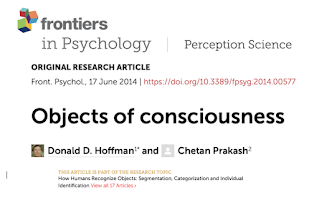Defending Physical Reality. Because, apparently somebody needs to.
Objections and Replies (authors conclusion)
Here we summarize helpful feedback from readers of earlier drafts, in the form of objections and replies.
~~~~~~~~~~~~~~~~~~~~~~~~~~~~~~~~~~
(Hoffman and Prakash) Conclusion
Hoffman starts out with an example of how the framing of questions (and scenarios) limits the quantity of potential understanding.
Hoffman: Belief in object permanence commences at 3 months of age and continues for a lifetime.
Object permanence beginning at 3 months? It’s a dreadfully impoverished description of what’s happening within an infant.
An infant is born with senses in place, if under developed. With a mind like a sponge, soaking in everything it can, processing on-the-fly and waking from every nap refreshed and with senses and brain a bit better connected than before and ready to soak in yet more.
A sense of object permanence starts developing right after birth, beginning with an awareness of, and bonding with, its parents and other intimate caregivers and builds out from there.
Learning to use its eyes, focus, turn towards sounds, touch and smell, and tiny muscles always fidgeting, tiny fingers, hands, arms, the legs, feet, toes - the wonderful progression from nonstop flailing to coordination, then lifting itself, then the nose dives while figuring out the muscular choreography needed to make crawling happen. Then, it’s on to walking and potty training.
All that is part of understanding object permanence which Hoffman treats like a bad thing.
In the infant's life, physical reality makes sure that the lessons of object permanence are build into the awareness of that little body, as well as mind.
Grasping the physical reality of object permanence and then learning how to manipulate it, is a prerequisite for becoming a balanced healthy person.
Those who can’t achieve such innate understanding become helpless and useless, confined to a life dependent on others taking care of them, or left to die.
Pretending away object permanence may be a fun intellectual mind-game for the bored, but it’s no space any person wants to exist within.
It inclines us to assume that objects exist without subjects to perceive them,
“It inclines us to assume” Let's unpack that ...









